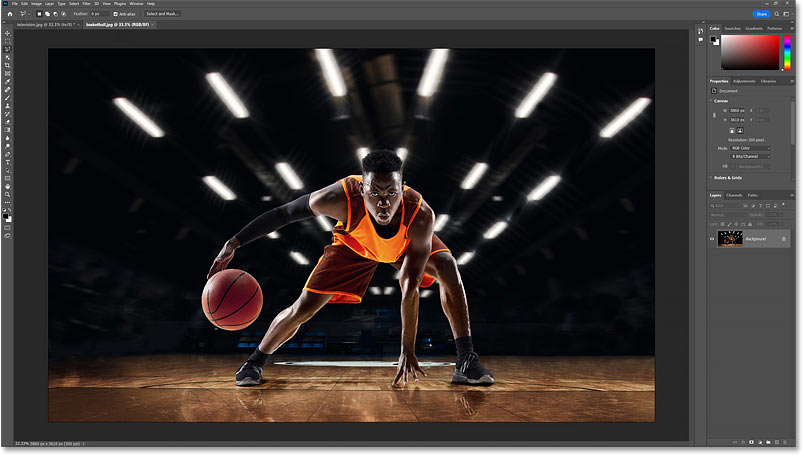Seamless Integration: A Comprehensive Guide on How to Paste an Image into a Selection in Photoshop

Introduction:
Adobe Photoshop stands as a powerhouse for digital image editing, providing users with an extensive toolkit to bring their creative visions to life. Among the fundamental skills in Photoshop is the ability to paste an image into a selection, a technique that allows for precise integration of elements, seamless compositing, and the creation of captivating visual compositions. In this extensive guide, we will explore the step-by-step process of pasting an image into a selection in Photoshop, unraveling the tools, techniques, and creative considerations that contribute to mastering this essential skill.
The Art of Compositing:
Elevating Visual Narratives:
Compositing is a technique that transcends basic image editing, allowing artists and designers to weave intricate visual narratives by seamlessly combining different elements. Pasting an image into a selection is a key aspect of compositing, enabling the integration of diverse subjects, backgrounds, or objects to craft compelling and cohesive compositions.
Precision and Seamless Integration:
The beauty of pasting an image into a selection lies in its precision. Whether you’re incorporating a new background, blending multiple images, or adding a focal point to your composition, this technique empowers you to achieve seamless integration, where the pasted image seamlessly merges with the existing elements, creating a harmonious and visually engaging result.
Step-by-Step Guide to Pasting an Image into a Selection:
Step 1: Open Your Images in Photoshop
Begin by launching Adobe Photoshop and opening both the image you want to paste and the image where you want to paste it. Ensure that the images have compatible resolutions for a smooth integration.
Step 2: Create a Selection
Use any selection tool available in Photoshop, such as the Rectangular Marquee tool, the Lasso tool, or the Magic Wand tool, to create a selection around the area where you want to paste the new image. Ensure that the selection aligns with the desired integration points.
Step 3: Copy the Image
Switch to the image you want to paste into the selection. Use the “Ctrl+C” (Windows) or “Command+C” (Mac) keyboard shortcut to copy the selected image. Alternatively, right-click on the selected image and choose “Copy” from the context menu.
Step 4: Paste into the Selection
Return to the destination image where you created the selection. Use the “Ctrl+V” (Windows) or “Command+V” (Mac) keyboard shortcut to paste the copied image into the selection. Photoshop will automatically create a new layer for the pasted image.
Step 5: Adjust and Transform
With the pasted image layer selected, use the Move tool (V) to position and adjust the pasted image within the selection. If needed, use the Transform tools (Ctrl+T or Command+T) to scale, rotate, or skew the pasted image for optimal integration.
Step 6: Refine the Edges (Optional)
To ensure a seamless blend, refine the edges of the pasted image. Right-click on the pasted image layer, choose “Select Layer Mask,” and then use tools like the Brush tool with a soft brush to mask out or blend edges as needed.
Step 7: Fine-Tune the Composition
Evaluate the overall composition and make additional adjustments as required. Consider aspects such as lighting, color matching, and perspective to achieve a cohesive and visually pleasing result.
Step 8: Save Your Composite Image
Once satisfied with the integration, save your composite image in the desired format. Consider saving the Photoshop (.PSD) file if you want to retain the layers for future adjustments.
Tips for Precision and Creativity:
- Perfect the Selection: Invest time in creating a precise and well-defined selection. The accuracy of your selection determines how seamlessly the pasted image integrates with the existing composition.
- Consider Lighting and Shadows: Pay attention to the lighting and shadow details in both the pasted image and the destination composition. Adjustments may be necessary to ensure a realistic and cohesive blend.
- Match Color and Tone: Use adjustment layers, such as Hue/Saturation or Color Balance, to match the color and tone of the pasted image with the surrounding elements. This enhances the overall harmony of the composition.
- Experiment with Blending Modes: Explore different blending modes for the pasted image layer to achieve unique effects. Modes like Overlay, Multiply, or Screen can influence how the pasted image interacts with the layers beneath.
- Combine Multiple Selections: For complex compositions, consider creating multiple selections and pasting different elements into each selection. This allows for intricate and layered compositing.
Creative Applications of Pasting into Selections:
- Fantasy and Surreal Art: Create fantastical and surreal scenes by pasting elements like mythical creatures, magical objects, or dreamlike landscapes into carefully crafted selections.
- Advertising and Marketing Collages: Craft visually engaging marketing materials by pasting product images into selections within lifestyle scenes, creating captivating collages that showcase products seamlessly.
- Portrait Enhancements: Enhance portrait photographs by pasting background elements or artistic overlays into selections. This technique allows for creative and personalized backdrops.
- Environmental Storytelling: Tell compelling stories by integrating characters or objects into specific environments. This approach is particularly effective in conveying narratives and concepts.
- Digital Art and Manipulation: Push the boundaries of digital art by pasting diverse images into intricate selections. Experiment with different genres, from abstract compositions to futuristic landscapes.
Conclusion:
Pasting an image into a selection in Photoshop is a versatile and essential skill for anyone involved in digital image editing, graphic design, or artistic pursuits. By following the step-by-step guide and incorporating tips for precision and creativity, you can confidently navigate the compositing process and elevate your visual creations to new heights.
As you experiment with pasting images into selections, remember that the true artistry lies in your ability to blend technical proficiency with creative intuition. Embrace the possibilities, push your boundaries, and let Photoshop be your canvas for crafting seamless and captivating visual stories through the art of compositing.




